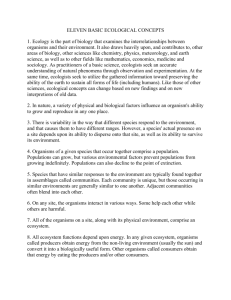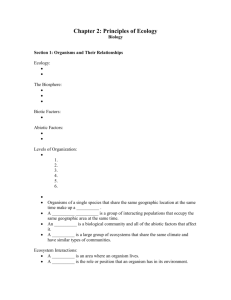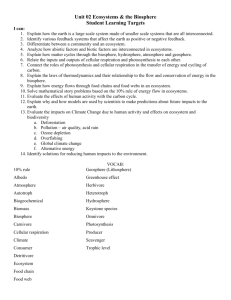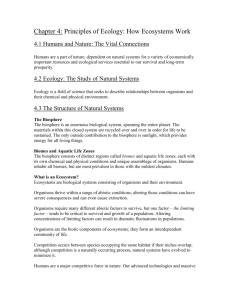File - Hoblitzell's Science Spot
advertisement
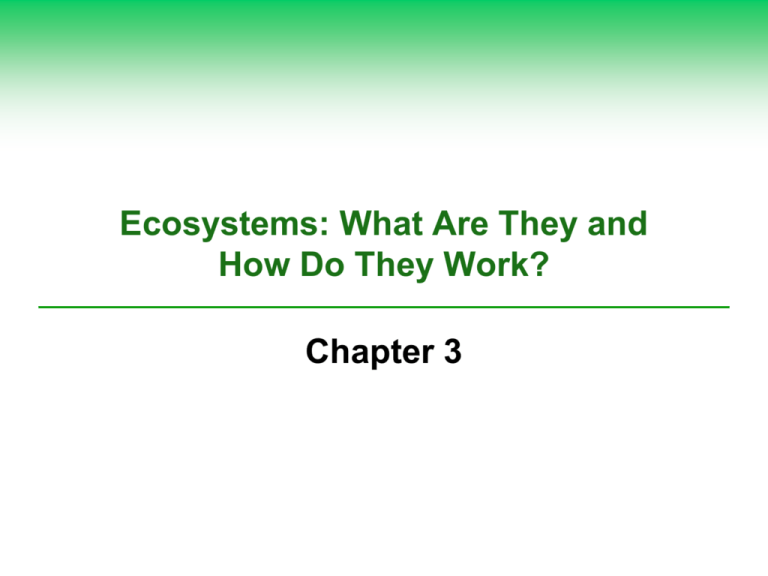
Ecosystems: What Are They and How Do They Work? Chapter 3 Core Case Study: Tropical Rain Forests Are Disappearing Cover about 2% of the earth’s land surface Contain about 50% of the world’s known plant and animal species Disruption will have three major harmful effects • Reduce biodiversity • Accelerate global warming • Change regional weather patterns Natural Capital Degradation: Satellite Image of the Loss of Tropical Rain Forest Santa Cruz, Boliva: June 1975 May 2003 3-1 What Is Ecology? Concept 3-1 Ecology is the study of how organisms interact with one another and with their physical environment of matter and energy. Cells Are the Basic Units of Life Cell Theory – theory that all living things are composed of cells Eukaryotic cell – membrane, nucleus, organelles Prokaryotic cell – membrane • bacteria (a) Eukaryotic Cell Nucleus (DNA) (b) Prokaryotic Cell Energy conversion Protein construction DNA (no nucleus) Cell membrane Cell membrane Protein construction and energy conversion occur without specialized internal structures Stepped Art Fig. 3-2, p. 52 Species Make Up the Encyclopedia of Life Species 1.75 Million species identified Insects make up most of the known species Perhaps 10–14 million species not yet identified www.eol.org project started in 2007 to list and describe all identified species. Ecologists Study Connections in Nature Ecology – study of how organisms interact with biotic and abiotic factors in their environment Levels of organization • Population – same species in same place at same time: ex. Field mice living in a cornfield • Genetic diversity – variations in population • Community – all populations of different species living in same place • Ecosystem – community of different species interacting w/ one another & w/ nonliving environment • Biosphere – parts of Earth’s air, water, & soil where life if found Biosphere Parts of the earth's air, water, and soil where life is found Ecosystem A community of different species interacting with one another and with their nonliving environment of matter and energy Community Populations of different species living in a particular place, and potentially interacting with each other Population A group of individuals of the same species living in a particular place Organism Cell Molecule Atom An individual living being The fundamental structural and functional unit of life Chemical combination of two or more atoms of the same or different elements Smallest unit of a chemical element that exhibits its chemical properties Stepped Art Fig. 3-3, p. 52 Population of Glassfish in the Red Sea Genetic Diversity in a Caribbean Snail Population Science Focus: Have You Thanked the Insects Today? Insects play a vital role in sustaining life on Earth • Pollinators • Eat other insects • Loosen and renew soil Scientists estimate the value of ecological services provided by insects in U.S. at $57 billion per year Reproduce rapidly Very resistant to extinction Insects don’t need humans, but we most certainly need them Importance of Insects Pollinator Pest Controller 3-2 What Keeps Us and Other Organisms Alive? Concept 3-2 Life is sustained by the flow of energy from the sun through the biosphere, the cycling of nutrients within the biosphere, and gravity. The Earth’s Life-Support System Has Four Major Components Atmosphere • Troposphere • Stratosphere Hydrosphere – liquid, gas, solid (permafrost too) Geosphere – core, mantle, crust Biosphere – thin layer of Earth ~ 9km thick Vegetation and animals Atmosphere Biosphere Soil Rock Crust Lithosphere Mantle Biosphere (living organisms) Atmosphere (air) Core Mantle Geosphere (crust, mantle, core) Crust (soil and rock) Hydrosphere (water) Fig. 3-6, p. 55 Life Exists on Land and in Water Biomes – large regions w/ distinct climate & species (especially plants) adapted to live there Aquatic life zones • Freshwater life zones • Lakes and streams • Marine life zones • Coral reefs • Estuaries • Deep ocean Major Biomes along the 39th Parallel in the U.S. Three Factors Sustain Life on Earth One-way flow of high-quality energy beginning with the sun – through living things via feeding – into environment as low quality energy (heat dispersed to air or water) – eventually back into space as heat • No round trips – high quality energy cannot be recycled Cycling of matter or nutrients throughout biosphere • Earth a closed system (essentially fixed supply of nutrients) • Nutrients are recycled Gravity • Allows planet to hold onto atmosphere • Enables movement & cycling of materials What Happens to Solar Energy Reaching the Earth? UV, visible, and IR energy Radiation • • • • Absorbed by ozone Absorbed by the earth Reflected by the earth Radiated by the atmosphere as heat Natural greenhouse effect Flow of Energy to and from the Earth Active Figure: Energy flow Animation: Energy flow in Silver Springs Active Figure: Energy flow from the Sun to Earth 3-3 What Are the Major Components of an Ecosystem? Concept 3-3A Ecosystems contain living (biotic) and nonliving (abiotic) components. Concept 3-3B Some organisms produce the nutrients they need, others get their nutrients by consuming other organisms, and some recycle nutrients back to producers by decomposing the wastes and remains of organisms. Ecosystems Have Living and Nonliving Components Abiotic • • • • • • Water Air Nutrients Rocks Heat Solar energy Biotic • Living and once living, also waste products Major Biotic and Abiotic Components of an Ecosystem Range of Tolerance for a Population of Organisms INSERT FIGURE 3-10 HERE Range of tolerance for a population of organisms, such as fish, to an abiotic environmental factor—in this case, temperature. These restrictions keep particular species from taking over an ecosystem by keeping their population size in check Several Abiotic Factors Can Limit Population Growth Limiting factor principle • Too much or too little of any abiotic factor can limit or prevent growth of a population, even if all other factors are at or near the optimal range of tolerance • Water or lack thereof will limit plant growth in a desert • Soil nutrients can limit types of plants • DO in aquatic ecosystems • Salinity in aquatic ecosystems Producers and Consumers Are the Living Components of Ecosystems (1) Trophic (feeding) levels Producers, autotrophs • Photosynthesis • 6CO2 + 6H2O + solar energy • Chemosynthesis • Plants, phytoplankton, algae Consumers, heterotrophs • Primary - herbivores • Secondary - carnivores • Third and higher level Decomposers – recycle nutrients • Certain types of bacteria & fungi C6H12O6 + 6O2 Producers and Consumers Are the Living Components of Ecosystems (2) Detritivores • Feed on wastes or dead bodies of other organisms • Mites, earthworms, catfish, vultures Aerobic respiration C6H12O6 + 6O2 6CO2 + 6H2O + ENERGY Anaerobic respiration, fermentation End products could be methane gas, ethyl alcohol, acetic acid, or hydrogen sulfide Detritivores and Decomposers on a Log Various detritivores and decomposers (mostly fungi and bacteria) can “feed on” or digest parts of a log and eventually convert its complex organic chemicals into simpler inorganic nutrients that can be taken up by producers. Energy Flow and Nutrient Cycling Sustain Ecosystems and the Biosphere One-way energy flow Nutrient cycling of key materials The Main Structural Components of an Ecosystem Natural capital: the main structural components of an ecosystem (energy, chemicals, and organisms). Nutrient cycling and the flow of energy—first from the sun, then through organisms, and finally into the environment as low-quality heat—link these components. Science Focus: Many of the World’s Most Important Species Are Invisible to Us Microorganisms • • • • Bacteria Protozoa Fungi phytoplankton Some are harmful Most are beneficial • Break down food we digest • Purify water • Produce food like bread, cheese, soy sauce Active Figure: Roles of organisms in an ecosystem 3-4 What Happens to Energy in an Ecosystem? Concept 3-4A Energy flows through ecosystems in food chains and webs. Concept 3-4B As energy flows through ecosystems in food chains and webs, the amount of chemical energy available to organisms at each succeeding feeding level decreases. Energy Flows Through Ecosystems in Food Chains and Food Webs Food chain Food web A Food Chain A food chain. The arrows show how chemical energy in nutrients flows through various trophic levels in energy transfers; most of the energy is degraded to heat, in accordance with the second law of thermodynamics. See an animation based on this figure at CengageNOW. Question: Think about what you ate for breakfast. At what level or levels on a food chain were you eating? Simplified Food Web in the Antarctic Greatly simplified food web in the Antarctic. Many more participants in the web, including an array of decomposer and detritus feeder organisms, are not depicted here. Question: Can you imagine a food web of which you are a part? Try drawing a simple diagram of it. Usable Energy Decreases with Each Link in a Food Chain or Web Biomass Ecological efficiency Pyramid of energy flow Usable energy available at each trophic level (in kilocalories) Tertiary consumers (human) 10 Secondary consumers (perch) 100 Primary consumers (zooplankton) Heat Heat Heat Decomposers Heat 1,000 Heat 10,000 Producers (phytoplankton) Generalized pyramid of energy flow showing the decrease in usable chemical energy available at each succeeding trophic level in a food chain or web. In nature, ecological efficiency varies from 2% to 40%, with 10% efficiency being common. This model assumes a 10% ecological efficiency (90% loss of usable energy to the environment, in Stepped Art the form of low-quality heat) with each transfer from one trophic level to another. Question: Why is a vegetarian diet Fig. 3-15, p. 63 more energy efficient than a meat-based diet? Some Ecosystems Produce Plant Matter Faster Than Others Do Gross primary productivity (GPP) rate at which ecosystem’s producers convert solar energy into chemical energy as biomass (their tissues) measured in energy production per unit area over time kcal/m2/year Net primary productivity (NPP) = GPP-R • To stay alive, grow, & reproduce, producers must use some of they energy stored in their biomass (R) • Rate at which producers use photosynthesis to produce & store chemical energy minus the rate they use some of their stored energy through respiration • Ecosystems and life zones differ in their NPP • NPP = biomass available as nutrients for consumers Estimated Annual Average NPP in Major Life Zones and Ecosystems Estimated annual average net primary productivity in major life zones and ecosystems, expressed as kilocalories of energy produced per square meter per year (kcal/m2/yr). Question: What are nature’s three most productive and three least productive systems? (Data from R. H. Whittaker, Communities and Ecosystems, 2nd ed., New York: Macmillan, 1975) Animation: Prairie food web Active Figure: Rainforest food web Animation: Diet of a red fox Animation: Prairie trophic levels 3-5 What Happens to Matter in an Ecosystem? Concept 3-5 Matter, in the form of nutrients, cycles within and among ecosystems and the biosphere, and human activities are altering these chemical cycles. Nutrients Cycle in the Biosphere Biogeochemical cycles, nutrient cycles • • • • • Hydrologic Carbon Nitrogen Phosphorus Sulfur Connect past, present , and future forms of life Water Cycles through the Biosphere Natural renewal of water quality: three major processes • Evaporation • Precipitation • Transpiration – evaporation from surfaces of plants • Also Condensation, Infiltration, Runoff Alteration of the hydrologic cycle by humans • Withdrawal of large amounts of freshwater at rates faster than nature can replace it • Clearing vegetation • Increased flooding when wetlands are drained Hydrologic Cycle Including Harmful Impacts of Human Activities Natural capital: simplified model of the hydrologic cycle with major harmful impacts of human activities shown in red. See an animation based on this figure at CengageNOW. Question: What are three ways in which your lifestyle directly or indirectly affects the hydrologic cycle? Science Focus: Water’s Unique Properties Properties of water due to hydrogen bonds between water molecules: • Exists as a liquid over a large range of temperature • Changes temperature slowly • High boiling point: 100˚C • Adhesion and cohesion • Expands as it freezes • Solvent • Filters out harmful UV Carbon Cycle Depends on Photosynthesis and Respiration C is basic building block of carbohydrates, fats, proteins, DNA, & other organic compounds Link between photosynthesis in producers and respiration in producers, consumers, and decomposers Additional CO2 added to the atmosphere • Tree clearing • Burning of fossil fuels Natural Capital: Carbon Cycle with Major Harmful Impacts of Human Activities Natural capital: simplified model of the global carbon cycle, with major harmful impacts of human activities shown by red arrows. See an animation based on this figure at CengageNOW. Question: What are three ways in which you directly or indirectly affect the carbon cycle? Active Figure: Carbon cycle Nitrogen Cycles through the Biosphere: Bacteria in Action (1) N major component of proteins, many vitamins, & DNA but can’t be used as found in atmosphere Nitrogen fixed into useful compounds • Lightning • Nitrogen-fixing bacteria – produce NH3 Nitrification – specialized soil bacteria convert NH3 and NH4+ to nitrate ions (NO3-) Denitrification – specialized bacteria in waterlogged soil & in bottom sediments of lakes, oceans, etc. convert NH3 and NH4+ back nitrate & nitrite ions & then to nitrogen gas (N2) & nitrous oxide gas (N2O) which are released to atmosphere Nitrogen Cycles through the Biosphere: Bacteria in Action (2) Human intervention in the nitrogen cycle • Additional NO when fuel burned at high temps (this can lead to acid rain) • Add N2O (greenhouse gas) through livestock wastes & inorganic fertilizers in soil • Destruction of forest, grasslands, and wetlands release stored nitrogen to atmosphere • Add excess nitrates to bodies of water • Remove nitrogen from topsoil when harvest Nrich crops, irrigation, burn/clearing Nitrogen Cycle in a Terrestrial Ecosystem with Major Harmful Human Impacts Natural capital: simplified model of the nitrogen cycle with major harmful human impacts shown by red arrows. See an animation based on this figure at CengageNOW. Question: What are three ways in which you directly or indirectly affect the nitrogen cycle? Annual Increase in Atmospheric N2 Due to Human Activities Global trends in the annual inputs of nitrogen into the environment from human activities, with projections to 2050. (Data from 2005 Millennium Ecosystem Assessment) Active Figure: Nitrogen cycle Phosphorus Cycles through the Biosphere Cycles through water, the earth’s crust, and living organisms Phosphates stored in sediment and rocks May be limiting factor for plant growth Impact of human activities • Clearing forests • Removing large amounts of phosphate from the earth to make fertilizers Phosphorus Cycle with Major Harmful Human Impacts Natural capital: simplified model of the phosphorus cycle, with major harmful human impacts shown by red arrows. Question: What are three ways in which you directly or indirectly affect the phosphorus cycle? Animation: Phosphorus cycle Sulfur Cycles through the Biosphere Sulfur found in organisms, ocean sediments, soil, rocks, and fossil fuels SO2 in the atmosphere from volcanoes also release H2S H2S also from anaerobic decomposition H2SO4 and SO4- - sulfuric acid & sulfate salts = acid deposition Human activities affect the sulfur cycle • Burn sulfur-containing coal and oil • Refine sulfur-containing petroleum • Convert sulfur-containing metallic mineral ores (Pb, Zn) Natural Capital: Sulfur Cycle with Major Harmful Impacts of Human Activities Natural capital: simplified model of the sulfur cycle, with major harmful impacts of human activities shown by red arrows. See an animation based on this figure at CengageNOW. Question: What are three ways in which your lifestyle directly or indirectly affects the sulfur cycle? Active Figure: Sulfur cycle 3-6 How Do Scientists Study Ecosystems? Concept 3-6 Scientists use field research, laboratory research, and mathematical and other models to learn about ecosystems. Some Scientists Study Nature Directly Field research: “muddy-boots biology” New technologies available • Remote sensors • Geographic information system (GIS) software • Digital satellite imaging 2005, Global Earth Observation System of Systems (GEOSS) – 10 year program Some Scientists Study Ecosystems in the Laboratory Simplified systems carried out in • • • • Culture tubes and bottles Aquaria tanks Greenhouses Indoor and outdoor chambers Supported by field research Some Scientists Use Models to Simulate Ecosystems Computer simulations and projections Field and laboratory research needed for baseline data We Need to Learn More about the Health of the World’s Ecosystems Determine condition of the world’s ecosystems More baseline data needed



